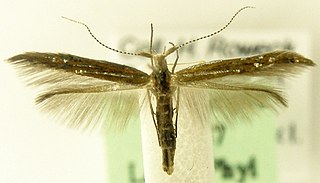
The Coleophoridae are a family of small moths, belonging to the huge superfamily Gelechioidea. Collectively known as case-bearers, casebearing moths or case moths, this family is represented on all continents, but the majority are found in temperate areas of the Northern Hemisphere. They are most common in the Palearctic, and rare in sub-Saharan Africa, South America, and Australia; consequently, they probably originated in northern Eurasia. They are relatively common in houses, they seek out moist areas to rest and procreate.
Goniodoma auroguttella is a moth of the family Coleophoridae. It is found in southern Europe, European Russia and Asia Minor. The habitat consists of steppe and semi-desert biotopes.

Goniodoma limoniella is a moth of the family Coleophoridae. It is found in western Europe and the Mediterranean region.
Goniodoma millierella is a moth of the family Coleophoridae. It is found in France, Italy and Tunisia.
Goniodoma nemesi is a moth of the family Coleophoridae. It is found in Croatia, Italy, Greece and Romania.
Goniodoma sinica is a moth of the family Coleophoridae. It is found in China.
Ceratocorys is a genus of photosynthetic free-living marine dinoflagellates first described in 1883 by Friedrich Stein. Currently consisting of 12 species, this genus is typically found at the water surface in tropical and subtropical ocean regions, and has both low nutrient requirements and salinity sensitivity. All species in the genus have a theca; 29 membrane-bound armored plates with anywhere from 2 to 6 spines protruding from the cell. They reproduce through binary fission at temperatures above 20 °C during asexual reproduction and whether or not they have sexual reproduction is not known. Due to its bioluminescent capabilities, the type species of this genus, Ceratocorys horrida, has many practical applications. Its bioluminescent response to water flow means it can act as a model organism for understanding planktonic reaction to water movement. It is also sensitive to environmental molecules; by measuring the bioluminescent response it can be used in rapid toxicity tests to detect the levels of different contaminants in water systems. Its presence is also an indicator of different oceanic phenomena like upwellings or tropical waters.


